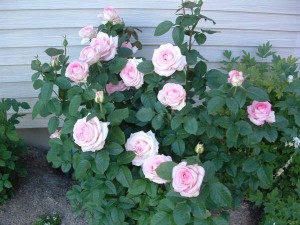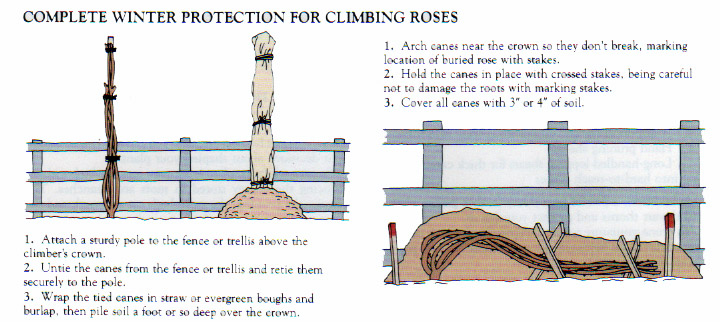Preparing Roses for Winter
Preparing Roses for Winter
Growing roses in east Idaho is nothing like growing roses in Portland, or Seattle, or Los Angeles. And that’s both good and bad. The good news is that we don’t have nearly the issues with bugs and diseases that they have in those areas. The bad news is that we have to figure out how to grow a zone 5 or 6 plant in the cold and wind of our zone 4 climate.
Many of the roses that are classified as hardy shrub roses are quite tolerant of severe winter temperatures, while others like hybrid teas can experience considerable damage and often death. Also, grafted roses stand a much greater chance of injury or death due to cold temperatures than do own-root roses. When selecting roses, select own root roses when possible, and always select cultivars that are rated to tolerate the coldest temperatures in your area based on USDA hardiness zone maps. Most of east Idaho is in zones 4 or 5, with higher elevations being zone 3.
Regardless of the rose type or variety, one of the most important things you can do to help your roses through the winter is to help them to go completely dormant in the fall. There are three things you can do to encourage their dormancy:
1. Stop fertilizing- Stop fertilizing early enough so growth begins to slow down. No fertilizer should be applied after early August.
2. Stop dead heading- Don’t cut off the flowers after the end of September and allow the plant to form hips (seed heads).
3. Reduce watering- Reducing irrigation in early October will encourage dormancy, but be sure to water well one last time before the ground freezes.
First, let’s talk about roses that don’t need extra protection. Hardy shrub roses, often called “landscape” roses are plants that generally don’t need extra protection for winter. They are hardier selections that should tolerate temperatures down to -30 degrees, and in some cases -40 degrees. And they are grown on their own root rather than being grafted, which means that if they die down to the ground in a hard winter they will still come back true from the root. This group includes the popular Knockout series, the Canadian bred Explorer series including such favorites as William Baffin and John Davis climbers, the Canadian bred Parkland series including the popular Winnipeg Parks and Morden Blush, and the Easy Elegance series bred by Bailey Nurseries of Minnesota. For these roses, the above mentioned suggestions for encouraging dormancy are probably all they will need. Although these roses require no mulching in the fall, it certainly doesn’t hurt and does provide some extra insurance in an unusually cold winter.
The whole idea behind winter protection is not to keep the plant warm, but to keep the plant uniformly cold and frozen all winter to prevent the damaging effects of alternate freezing and thawing. There are many methods to provide winter protection for roses, but whatever method you choose, don’t begin covering plants too early. Wait until a hard killing frost when the temperature has dropped into the teens for several nights, and preferably when there is about a 1/2 inch of frost in the ground.
Prior to covering, remove any foliage or other debris that might harbor disease for the next season. Some tall roses may need minor pruning to reduce their height; however, at this point pruning should be kept to a minimum. Always leave the canes at least 18″ tall. The majority of the pruning will be done in the spring to remove dead and damaged canes.
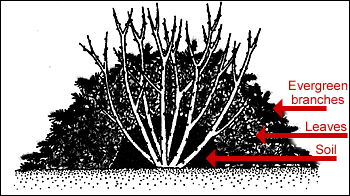 The preferred method of protecting roses against east Idaho winters is to pile up soil or compost over the plant to a depth of about 8 to 12 inches. It is important that the material be well drained. Wet and cold is far more damaging to roses than dry and cold. Do not scrape up soil from around the plant to “hill” it up for winter. That can cause root injury and increase the chance of winter damage. It is much better to purchase well drained compost or soil for this purpose (Soil Pep works well), or bring it in from another area of the garden. Then in the spring it can be spread throughout the rose bed or used elsewhere in your garden. After the soil mound has frozen, cover the mound with evergreen boughs, leaves, or straw to help insulate and keep the soil frozen.
The preferred method of protecting roses against east Idaho winters is to pile up soil or compost over the plant to a depth of about 8 to 12 inches. It is important that the material be well drained. Wet and cold is far more damaging to roses than dry and cold. Do not scrape up soil from around the plant to “hill” it up for winter. That can cause root injury and increase the chance of winter damage. It is much better to purchase well drained compost or soil for this purpose (Soil Pep works well), or bring it in from another area of the garden. Then in the spring it can be spread throughout the rose bed or used elsewhere in your garden. After the soil mound has frozen, cover the mound with evergreen boughs, leaves, or straw to help insulate and keep the soil frozen.
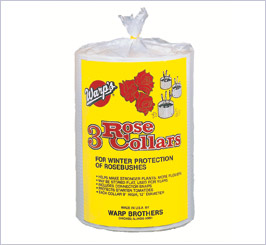 I have personally found it very convenient to use rose collars when covering my roses. It offers a bit more protection without requiring quite as much mulch, and it looks nice and tidy. The white plastic collar is placed around the rose to reflect heat and contain the mulch. The collar is then filled with soil, compost or bark dust and allowed to freeze. It can then be mulched with evergreen boughs or straw. The benefit of the collar is that it holds the soil in place all winter and prevents it from being washed or eroded away, exposing roses to possible winter damage.
I have personally found it very convenient to use rose collars when covering my roses. It offers a bit more protection without requiring quite as much mulch, and it looks nice and tidy. The white plastic collar is placed around the rose to reflect heat and contain the mulch. The collar is then filled with soil, compost or bark dust and allowed to freeze. It can then be mulched with evergreen boughs or straw. The benefit of the collar is that it holds the soil in place all winter and prevents it from being washed or eroded away, exposing roses to possible winter damage. 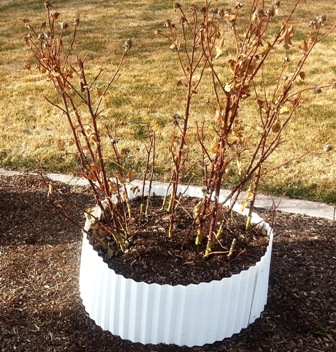 The rose collars come in a package that will make three cylinders 12″ wide. Except for the smallest of roses, I prefer to connect two together to make the cylinders 24″ wide. It takes more Soil Pep, but it is easier to place around the roses and provides more protection.
The rose collars come in a package that will make three cylinders 12″ wide. Except for the smallest of roses, I prefer to connect two together to make the cylinders 24″ wide. It takes more Soil Pep, but it is easier to place around the roses and provides more protection.
Styrofoam rose cones are often used, but I don’t recommend them. I’ve personally not had good luck with them, and I know many people who have had the same experience. If you do use them, be sure to mulch the base of the rose and make 1″ holes in the top of the cone for additional ventilation on warm days.
Climbing roses offer additional challenges regarding winter protection. In our climate, marginal varieties may need to be removed from their supports and bent to the ground, then covered with 8-12 inches of soil and mulch. When laying climbers on the ground for covering, you need to be very careful not to crack or break the stems. As the weather gets colder their long stems are not as pliable, and they are easily cracked. You may have to use a shovel to cut the roots on one side of the plant in order to get the plant to lay down flat on the ground.
Another method that can be used is to physically pack straw and/or corn stalks around the canes while they are still attached to the trellis or support. The straw is held in place with twine to keep it in place over the winter. Burlap can then be used to wrap the entire plant, providing protection as well as holding the straw in place. Hardy climber/ramblers like William Baffin and John Davis do not need protection.
And remember. The odds of healthy roses making it through severe winters are much greater than for roses weakened by disease, drought, insects, or nutrient deficiencies. So keeping your roses healthy and happy through the spring and summer will help ensure their survival during our east Idaho winters.



